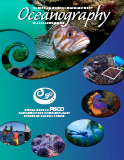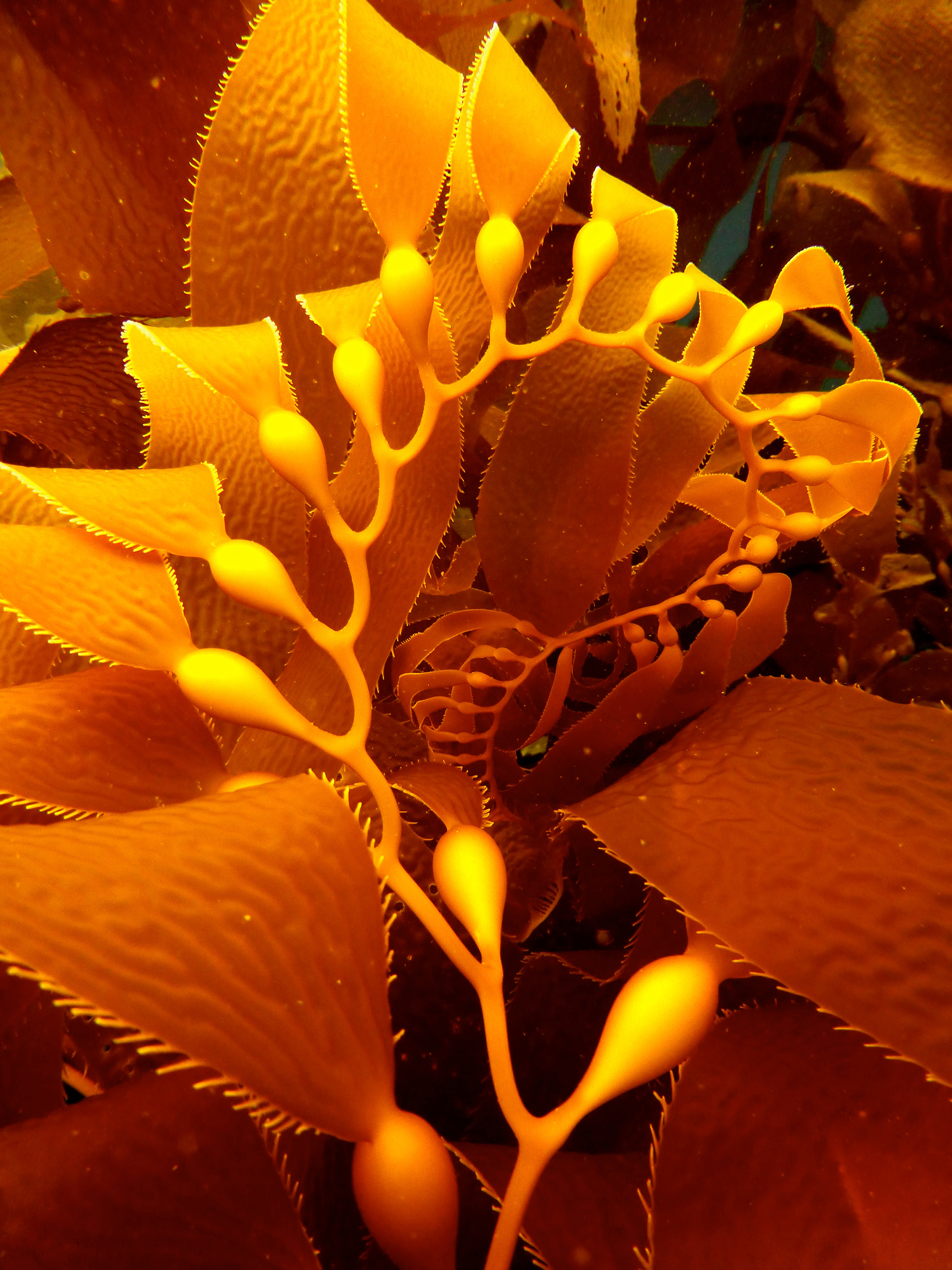INTRODUCTION
A key role of science is to inform decisions made by individuals and by institutions so their choices can be more robust (Lubchenco, 1998). Informing decisions is not the same as dictating specific outcomes. Science—if it is considered—is only one of many factors influencing a decision; values, economics, personal history, and politics often weigh heavily in decision-making, with trade-offs among them common (Fischhoff, 2013; Fischhoff and Scheufele, 2013; von Winterfeldt, 2013). Unfortunately, scientific information about a topic is often not readily available to decision-makers. For science to be considered seriously alongside a multitude of other factors, it needs to be not only available but also understandable, credible, salient, and relevant (Lubchenco, 1998; Cash et al., 2003; Sullivan et al., 2017). Toward that end, relationships between scientists and stakeholders matter, and trust needs to develop over time with sustained and productive engagement.
The kind of scientific information that is relevant to natural resource management and related environmental decisions includes basic information about the system and people’s choices for altering future system states (Figure 1). For example, following the nested set of questions in Figure 1, scientists might (1) discover the key processes that determine the patterns in an ecosystem like the California Current Large Marine Ecosystem (CCLME); (2) document temporal changes such as water temperature, dissolved oxygen, and acidification, and their associated impacts on key species and human uses, paying attention to which changes are outside normal historic fluctuations; (3) integrate information from (1) and (2) to forecast the likely changes in physical, biological, and ecological conditions in the ecosystem and their potential impacts on human uses of the ecosystem; (4) work with stakeholders and decision-makers to identify potential options or actions for altering the drivers of change or reducing impacts, for example, through mitigation or adaptation or both; options might include business as usual (no action), or a variety of active interventions; and (5) evaluate the likely consequences of these different options, their trade-offs and co-benefits, and the feasibility and costs of each. (See Bottrill et al., 2008, for a different approach.) Each step in this series can provide useful information to decision-makers, information that is policy-relevant but not policy-prescriptive, and is focused on both the biogeophysical and the socioeconomic components of the coupled system. No action is recommended; rather, scientific information is provided to clarify the trade-offs or co-benefits, costs, and feasibility of different actions so that decisions can be better informed.

Figure 1. The types of information about environmental changes that may be pertinent to decisions made by individuals or institutions. Although answers to later questions build on earlier ones, it is important to continually incorporate new information and update responses accordingly. > High res figure
|
Citizens, managers, and policymakers often ask scientists: What is happening? What can I/we do about it? Answers to the first question require knowledge of (1) and (2) in Figure 1. Development of solutions to problems (4) and evaluation of options for responses (5) also depend intimately upon knowledge of how the system works and is changing (1) and (2) as well as its likely future states (3). Especially in dynamic, complex, coupled human-natural systems such as the nearshore ocean, deep knowledge about the processes affecting patterns and the rates and likely causes of changes are key to providing guidance for policy, management, and public understanding.
From the outset, the Partnership for Interdisciplinary Studies of Coastal Oceans (PISCO) included a strong focus on connecting science with policymakers, managers, and the public (Menge et al., 2019c, in this issue). PISCO investigators and funders (initially the Packard Foundation, later the Moore Foundation, and then others; see Menge et al, 2019c, in this issue) considered outreach as important as documenting patterns, deciphering processes, and providing interdisciplinary training. The goals of the research and monitoring components were to understand the fundamental, coupled biogeophysical and ecological processes of the inner shelf of the CCLME and to track and understand changes through time. The goal of PISCO’s outreach program was to connect the dots between that information and those who might be interested in, benefit from, or contribute to PISCO scientific findings, including managers and policymakers who could incorporate scientific information into decision-making processes.
PISCO’s commitment to outreach reflected the philosophy that scientists have an obligation to share what they know with society (Lubchenco, 1998, 2017), as well as the assumption that the scientists who are experts are in the best position to share knowledge of that system, especially when they are adept at communication and engagement.
The Science-User Connections
Multiple models exist for connecting scientific knowledge to decision-makers. In some models, scientists initiate an interaction, for example, by offering information; in others, users of the information seek answers from scientists. These “push vs. pull” models can be an ongoing, interactive, and iterative process (e.g., Cooley et al., 2015).
Although initially conceived primarily as a unidirectional transfer of information from scientists to users, through time, PISCO outreach evolved to be more multidirectional. The initial and current foci reflect larger shifts in awareness by scientists of the importance of moving beyond either a “pipeline” or a “deficit model” approach focused on one-way “communication” (science to users) to an “engagement” approach involving active, two-way listening and sharing, as well as opportunities for citizen science and co-creation of knowledge (Fischhoff and Scheufele, 2013; Lubchenco, 2017).
PISCO research encompasses both “basic” science and “use-inspired” science, sensu Stokes (1997), and both have entailed considerable outreach and engagement. PISCO’s basic science seeks to understand fundamental dynamics of the inner shelf of the CCLME (Figure 1, Question #1). The long time series of data on status and trends in oceanography and ecological communities (Question #2), coupled with experiments to understand the processes producing those patterns, enabled PISCO scientists to understand—and explain to a variety of lay audiences—some of the “surprises” that appeared in the CCLME in the last two decades. These surprises include the novel appearance of nearshore hypoxia (“dead zones”) in 2002, the sea star wasting disease that swept the West Coast starting in 2013, and the concurrent (2013–2015) “marine heatwaves” (Di Lorenzo and Mantua, 2016; Menge et al., 2019a, in this issue; Chan et al., 2019, in this issue).
PISCO’s use-inspired science seeks to advance fundamental knowledge that is also immediately relevant to society, and to use that knowledge to help society make smart decisions, such as how to use the ocean sustainably. For example, responding to policymakers’ requests for guidance about how to design marine protected areas (MPAs), PISCO scientists created new syntheses and developed new insights that directly informed local-to-international MPA policies and practices (see below). Other applications included informing management of fisheries, endangered species (such as abalone), oil spills, and water quality. In a similar fashion, requests for guidance about more holistic approaches to uses of the ocean prompted development of ecosystem-based management approaches that have influenced national to international actions (McLeod et al., 2005; McLeod and Leslie, 2009; Lubchenco and Sutley, 2010).
Enabling Conditions for Productive Science-User Interactions
A combination of factors set the stage for significant interactions between PISCO scientists and potential users:
- PISCO Principal Investigators (PIs) created a culture that embraced the importance of communication, outreach, and engagement.
- Many PISCO PIs actively engaged in outreach, setting an example for students and sending a clear message to policymakers that we were open to working with them.
- PISCO initially had funds for three “policy coordinators” whose jobs were to (a) make connections with potential users and learn of their interests and needs, (b) seek or create opportunities to share PISCO science, and (c) ensure that scientists were prepared to connect effectively. The latter entailed, for example, creating training opportunities for scientists to become “bilingual” (able to speak fluently with both scientific and lay audiences). Policy coordinators also created user-focused communication products such as PISCO Coastal Connections (http://www.piscoweb.org/resources-print). Over time, these activities created relationships and trust that enabled productive interactions with decision-makers.
- PISCO had “sister” boundary organizations with complementary missions that played key roles in enabling effective outreach. These included COMPASS (https://www.compass-scicomm.org), the Leopold Leadership Program (https://leopoldleadership.stanford.edu), and the National Center for Ecological Analysis and Synthesis (NCEAS; https://www.nceas.ucsb.edu). COMPASS and the Leopold Program were funded by the Packard Foundation. NCEAS was a joint effort of the National Science Foundation and the University of California, Santa Barbara.) Most of the PISCO PIs and numerous postdocs and graduate students participated in COMPASS trainings and NCEAS groups; many PIs have been Leopold Fellows.
- PISCO PIs developed novel courses to train young scientists in effective communication and engagement with managers and decision-makers, thus mainstreaming communication and engagement skills and sending a clear message that engagement is encouraged and rewarded.
- Oregon and California citizens, fishers, business leaders, managers, and policymakers have generally been open to engagement with scientists. The California Ocean Protection Council, the California Ocean Science Trust, and the California and Oregon Departments of Fish and Wildlife have been critical PISCO partners for decades.
These enabling conditions set the stage for engagement by PISCO scientists, staff, and students. Below are three examples of how PISCO’s science has been useful at local to international levels.
1. Marine Protected Areas (MPAs)
The design, use, and evaluation of MPAs was an early focus of PISCO. Others had been working on MPAs for decades, but lacked answers to questions frequently posed by policymakers and nongovernmental organizations (NGOs): How many MPAs do we need? How big should they be? How far apart? Where? What is the relationship to fisheries? Here, we describe the engagement of PISCO scientists with the public, managers, and policymakers involved in MPAs (see also Botsford et al., 2014; Sullivan et al., 2017; Carr et al., 2019, in this issue).
A PISCO PI (author Lubchenco) organized a symposium at the 1997 annual meeting of the American Association for the Advancement of Science (AAAS) to evaluate existing science on MPAs. One conclusion was that those MPAs that are fully protected from any extractive activities (often called either marine reserves or fully protected MPAs; http://wcmc.io/8408) were a powerful but underutilized conservation tool (Allison et al., 1998). Speaking at a AAAS press conference organized by COMPASS, Lubchenco reported that far less than 0.1% of the ocean was protected in reserves and, based on the published evidence for their merits, called for setting a bold target of protecting 20% of the ocean in reserves by 2020 (Hill, 1997). The tantalizing potential to make significant progress on MPA science prompted three PISCO PIs (authors Lubchenco, Gaines, and Palumbi) to propose an NCEAS Working Group on the Science of Marine Reserves. Multiple PISCO PIs, postdocs, and graduate students participated, along with global experts in physical oceanography, larval dispersal, ecology, genetics, conservation biology, and fisheries.
The NCEAS-PISCO working group substantially advanced scientific knowledge about reserves and shed light on many practical issues relevant to their use and design (Lubchenco et al., 2003a,b). The group proposed the novel idea of a network of reserves as a tool to provide some of the benefits of a single large reserve and yet coexist with and benefit extractive uses such as fisheries. New models explored the relationships between larval and adult dispersal, physical oceanography, reserve configuration, catastrophes, climactic variability, and fishery effort (see below).
In 2000, COMPASS and PISCO co-organized a workshop with West Coast state and federal agencies, NGOs, and academic scientists to share the NCEAS results. The managers, policymakers, and NGOs welcomed the information and urged scientists to share them widely, for example, through a Scientific Consensus Statement on Marine Reserves. PISCO scientists produced a plain-language consensus document that was later signed by over a hundred experts on MPAs (https://www.nceas.ucsb.edu/consensus/consensus.pdf) and released at a symposium and press conference at the 2001 AAAS meeting. The Consensus Statement drew considerable interest, was widely circulated, and reached many audiences that would not generally read scientific papers.
Many papers from the NCEAS working group were published individually, for example, Hastings and Botsford (1999), Botsford et al. (2001), Palumbi (2001), and Kinlan and Gaines (2003). Sixteen others were published as a special issue of Ecological Applications (Lubchenco et al., 2003a,b). They generated considerable global interest and a second NCEAS working group.
The working group provided ample opportunities for PISCO graduate students and postdoctoral researchers to conduct cutting-edge science and obtain training and experience in science communication and outreach—speaking at press conferences and interacting with policymakers, media, and stakeholders. Many have become scientific leaders in their own right and continue to engage with non-scientific audiences.
Keen public interest in scientific findings, coupled with California’s 1999 Marine Life Protection Act (MLPA) mandating the creation of a network of MPAs and reserves, prompted PISCO scientists to develop a suite of outreach documents to translate the findings into lay language and infographics. They produced the first The Science of Marine Reserves (SMR) booklet (Lubchenco et al., 2002), which included infographics about fundamental concepts, findings, and key design features of reserves that have been widely circulated. For example, a meta-analysis of hundreds of reserves around the world concluded that fully protected MPAs are effective in restoring or protecting biodiversity, increasing average body size, and species diversity (Figure 2). Another graphic drew attention to the importance of protecting a range of habitats for the numerous species that move among habitat types during their life cycles (Figure 3).
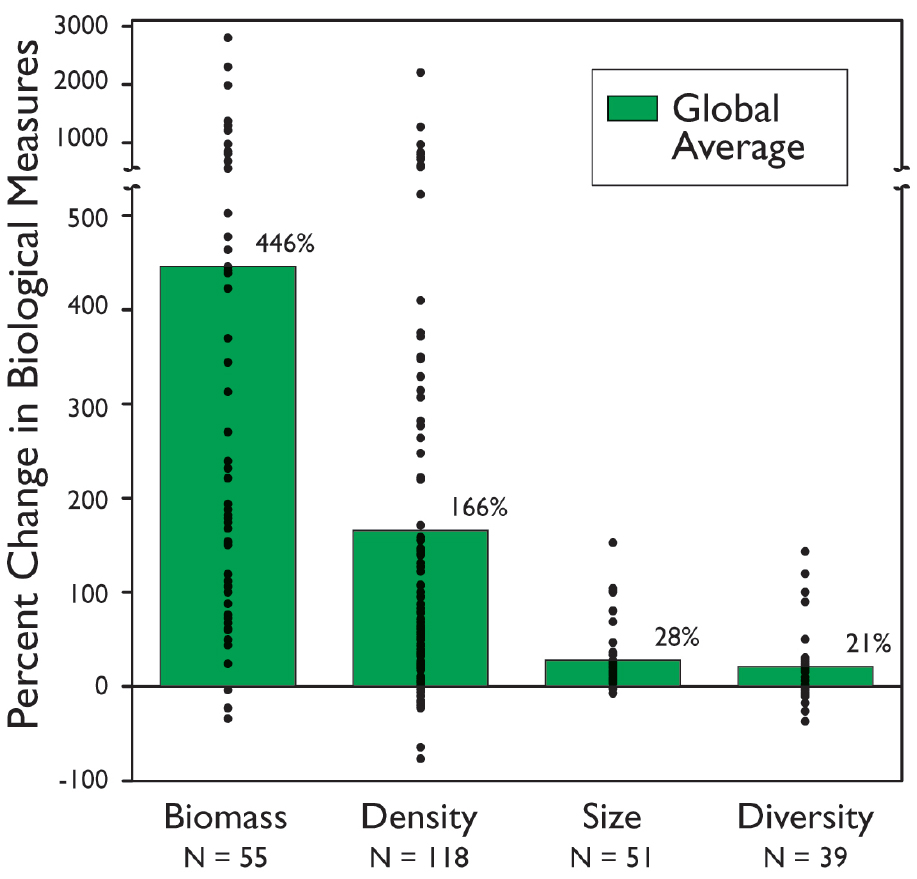
Figure 2. Average changes (green bars) in fishes, invertebrates, and seaweeds within marine reserves around the world. Although changes varied among reserves (black dots), most reserves had positive changes. Credit: PISCO, Science of Marine Reserves booklet; data from Lester et al. (2009). > High res figure
|

Figure 3. Many species like this bocaccio, Sebastes paucispinis, use multiple habitats during their life cycles. Credit: PISCO, Science of Marine Reserves booklet; art by Ryan Kleiner. > High res figure
|
The initial SMR booklets were popular and triggered requests to produce other, regionally focused booklets using global information and local case studies. To date, five versions have been developed (regionally tailored and with global content updated), over 24,000 booklets have been distributed in 58 countries, and an unknown number have been downloaded (http://www.piscoweb.org/portfolio/science-marine-reserves-booklets; see Grorud-Colvert et al., 2019, in this issue).
When California passed the MLPA in 1999 to redesign the state’s network of MPAs, PISCO science and scientists contributed substantially. Two PIs and authors of this paper (Carr and Gaines) co-chaired and two additional PI/authors (Palumbi, White) along with PI Pete Raimondi participated on the MLPA Science Advisory Team; two PISCO policy coordinators (Satie Airamé and Emily Saarman) provided essential technical support. The team generated analyses and design guidelines to provide the scientific basis for decisions by managers, policymakers, and stakeholders. PISCO’s long-term monitoring program provided information to inform key design criteria, and PISCO scientists conducted additional analyses for the planning process (e.g., Klein et al., 2008). Gaines et al. (2010) addressed the relationship between MPAs and fisheries, which was of particular interest for many.
A unique aspect of this process was the development of simple “rules of thumb” to translate robust MPA science into targets for MPA size, spacing, and replication (Saarman et al., 2013; Carr et al., 2019, in this issue). The “rules” translated basic biological information about the juvenile dispersal and adult movement of the target species (identified by stakeholders) into guidelines adopted by the state about the distance between reserves and the size of individual MPAs, respectively (California Department of Fish and Game, 2008). These tools proved extremely useful because they gave members of the public the ability to propose sites for MPAs that met the design criteria as well as means to easily compare across the various options. Through time, these broadly applicable, simple rules of thumb provided key management targets for agencies, scientists, and the public to use in evaluating the MPAs. Moreover, additional monitoring, evaluation, and new research allowed the guidelines to evolve and thus be even more useful (Saarman et al., 2013; White et al., 2013).
In parallel, PISCO scientists were intimately involved in the consideration, establishment, monitoring, and evaluation of marine reserves in Oregon. Beginning in 2000, this included presentations to three successive governors, members of the legislature, state boards and agencies, the Oregon Ocean Policy Advisory Council, and a range of stakeholders and communities. PISCO science and scientists contributed to a key reserve size and spacing report for the Oregon siting process (Heppell et al., 2008). In 2012–2016, Oregon established five marine reserves, with PISCO scientists continuing to assist with advice and monitoring.
PISCO scientists have been key to the evaluation of MPAs in California and Oregon (see Carr et al., 2019, in this issue). Many PISCO long-term monitoring sites in both states were later chosen as MPAs or reference sites. PISCO data collected prior to designation of the MPAs and continued PISCO monitoring have enabled a robust evaluation of changes in fished populations and human activity levels inside and outside MPAs (e.g., Caselle et al., 2015). The availability of these data has led to advances in theoretical understanding of how populations respond to MPAs through model-based predictions of how much and how quickly population increases should be expected, and how changes inside MPAs are likely to affect fisheries outside MPAs (reviewed by White et al., 2011). Because PISCO scientists have been in close contact with the relevant managers, these results were included in California’s Marine Protected Area Monitoring Action Plan (CDFW and OPC, 2018).
Building on these experiences, PISCO scientists contributed significantly to national MPA efforts, including serving on NOAA’s Marine Protected Areas Federal Advisory Committee (Gaines, Carr) and the Pew Oceans Commission (POC) (Lubchenco) and participating in one of POC’s white papers (Palumbi). They have also contributed to global MPA efforts (Grorud-Colvert et al., 2010; Barner et al., 2015; Lubchenco and Grorud-Colvert, 2015; Sala et al., 2018; Grorud-Colvert et al., 2019, in this issue). More recently, as nations review their MPA commitments under the Convention on Biological Diversity and the Sustainable Development Goals, PISCO scientists have led international efforts to harmonize and clarify internationally used MPA terms (http://wcmc.io/8408).
In summary, PISCO has contributed substantially to the advancement of the science of MPAs as well as their design, implementation, monitoring, and evaluation in California, Oregon, the United States, and globally.
2. Ocean Acidification and Hypoxia: Policy Impacts
PISCO scientists have contributed to the understanding of two major, related biogeochemical changes in the coastal ocean that have substantial economic and social implications: ocean acidification and hypoxia (referred to collectively as OAH). Scientific aspects are detailed elsewhere (Chan et al., 2019, in this issue). Engagement of PISCO scientists with the public, industry, managers, and policymakers was critical in making scientific knowledge of OAH useful to society.
A dramatic episode of hypoxia (low oxygen conditions that lead to dead zones) occurred along the Pacific Northwest coast in 2002. Reports from alarmed crab fishers about pots full of dead crabs prompted local managers to seek PISCO’s assistance. Low dissolved oxygen (DO) levels were quickly identified as the cause of crab mass mortality. Subsequent research revealed an accelerating risk of upwelling-driven hypoxia as a result of climate change, and highlighted the impacts of hypoxia on a diversity of marine organisms (Grantham et al., 2004; Chan et al., 2008; Keller et al., 2010).
As understanding of the vulnerability of the CCLME to upwelling-driven hypoxia emerged, the threats posed by ocean acidification also became more obvious. In a landmark paper, Feely et al. (2008) demonstrated that the CCLME is at high risk for early impacts of OA, largely because upwelled waters that are more acidic than surface waters were already reaching levels considered corrosive to shelled organisms. The emergence of the dual threats of OA and hypoxia triggered an abrupt shift in understanding, moving climate change and OA from distant concerns to more immediate challenges for policy, management, and industry. (See Barton et al., 2015, for related scientist-industry interactions.)
Policymakers and scientists were initially uncertain as to what policy responses, if any, could help address OAH. PISCO scientists and colleagues provided insight by focusing on the questions in Figure 1 and sharing their emerging understanding. Specially designed outreach materials facilitated communications, despite the dynamic nature of seasonal hypoxia. PISCO scientists frequently briefed legislators, agency leaders, the Oregon governor, fishermen, communities, and the media. During intense hypoxia years, PISCO was typically engaged in over 50 OAH outreach events a year.
Following the discovery of hypoxia and acidification in the CCLME, PISCO scientists and partners worked to integrate the previously siloed policy discussions about OA and hypoxia and to connect scientific experts and policymakers. They tapped into relationships previously established around climate change (Governor’s Advisory Group on Global Warming, 2004, co-chaired by Lubchenco; the subsequent 2004 West Coast Governors’ Global Warming Initiative; and the 2006 West Coast Governors’ Agreement on Ocean Health). As a result, the governors of Washington, Oregon, and California, and the premier of British Columbia established the West Coast OAH Science Panel in 2013 to synthesize research and its implications for managers and policymakers, drawing on the work of the Washington State Blue Ribbon Panel on Ocean Acidification (Feely et al., 2012; Sullivan et al., 2017). Authors Barth and Chan served as member and co-chair, respectively. Bringing together regional scientific and policy expertise had the benefit of diversifying the knowledge base, clarifying the science needs of policymakers, and fostering local and cross-jurisdictional commitments to actions.
The panel’s findings, released in April 2016, highlighted the risks posed by OAH for the region’s ecosystems and economies and emphasized the importance of developing local mitigation and adaptation options (Chan et al., 2016). Policy adoption of the panel’s recommendations was swift. By September 2016, California passed two bills directing action on OAH; in 2017, Oregon passed legislation creating the Oregon Coordinating Council on OAH. In parallel, the West Coast governors, through the Pacific Coast Collaborative, established the International Alliance to Combat Ocean Acidification (OA Alliance; https://www.oaalliance.org/). This Alliance provides a framework for organizations, municipalities, and countries to develop and commit to their own OA action plans to identify and acquire needed scientific knowledge, take meaningful mitigation and adaptation actions, heighten public awareness, and strengthen international coalitions. California adopted its OA Action Plan in October of 2018, and Oregon released its draft plan in June of 2019.
One common element of these responses has been to grow formal processes for ensuring that legislators and managers have access to the latest scientific understanding of OAH. California law AB2139 requires the California Ocean Protection Council to convene an OAH Science Task Force (co-chaired by Chan) to review and advise on OAH science. Oregon SB1039 established an OAH Coordinating Council (co-chaired by an academic scientist, Barth, and an agency representative), comprised of academic scientists, agency leadership, and stakeholders, to provide the legislature with biennial recommendations. In parallel, PISCO scientists and numerous colleagues have vastly expanded their monitoring endeavors to better track and understand the extent of OAH (Figure 4).
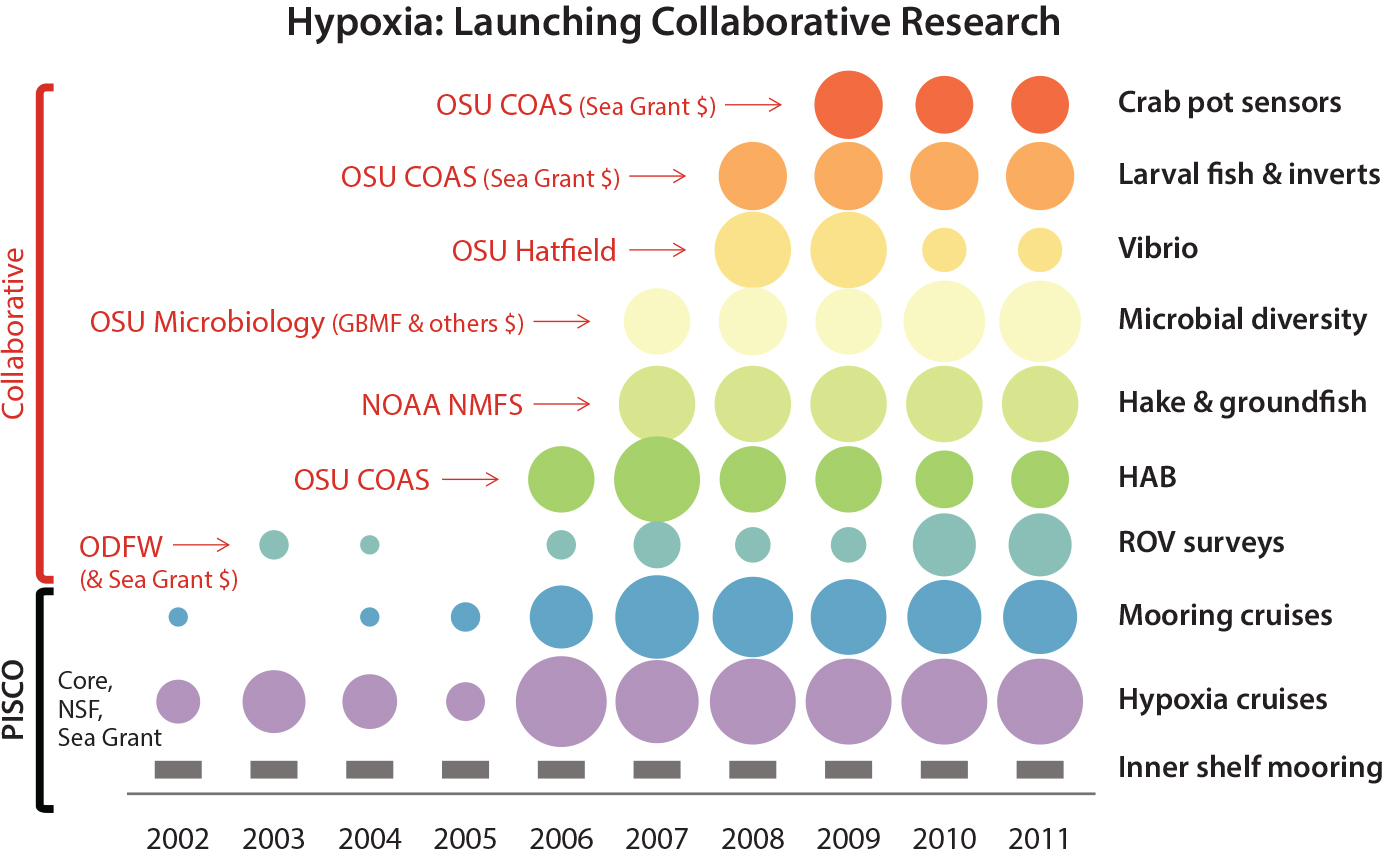
Figure 4. Following the novel appearance of hypoxia in 2002, PISCO partnered with an increasing number of collaborators to expand the spatial and temporal coverage of sampling. Circle size represents relative scale of effort. GBMF = Gordon and Betty Moore Foundation. OSU COAS = Oregon State University College of Earth, Ocean, and Atmospheric Sciences. OSU Hatfield = OSU Hatfield Marine Science Center. OSU Microbiology = OSU Department of Microbiology. NOAA NMFS = NOAA National Marine Fisheries Service. ODFW = Oregon Department of Fish and Wildlife. ROV = Remotely operated vehicle. HAB = Harmful algal bloom. > High res figure
|
Thus, in a relatively short time, we have seen science inform new legislation, trigger new scientific partnerships, and catalyze new science-policy engagement in the CCLME and beyond (Figure 5). Scientific understanding and monitoring are increasingly seen as valuable. Prior to the emergence of OAH, it was difficult to foresee any demand for sustained, “in the water,” real-time or near-real-time observations. Today, however, fishermen and managers routinely rely on real-time data as well as time-series data to better understand weekly to yearly changes in the coastal ocean, particularly in nearshore state waters that were previously not monitored for OAH. Similarly, managers are increasingly considering the implications of OAH for other priorities such as MPAs (Kroeker et al., 2019, in this issue), at-sea discharge of waste from seafood processing (USEPA, 2019), and fisheries (Keller et al., 2017). New partnerships between NOAA, Oregon Department of Fish and Wildlife, and PISCO enable fishery stock assessments to include impacts of hypoxia.
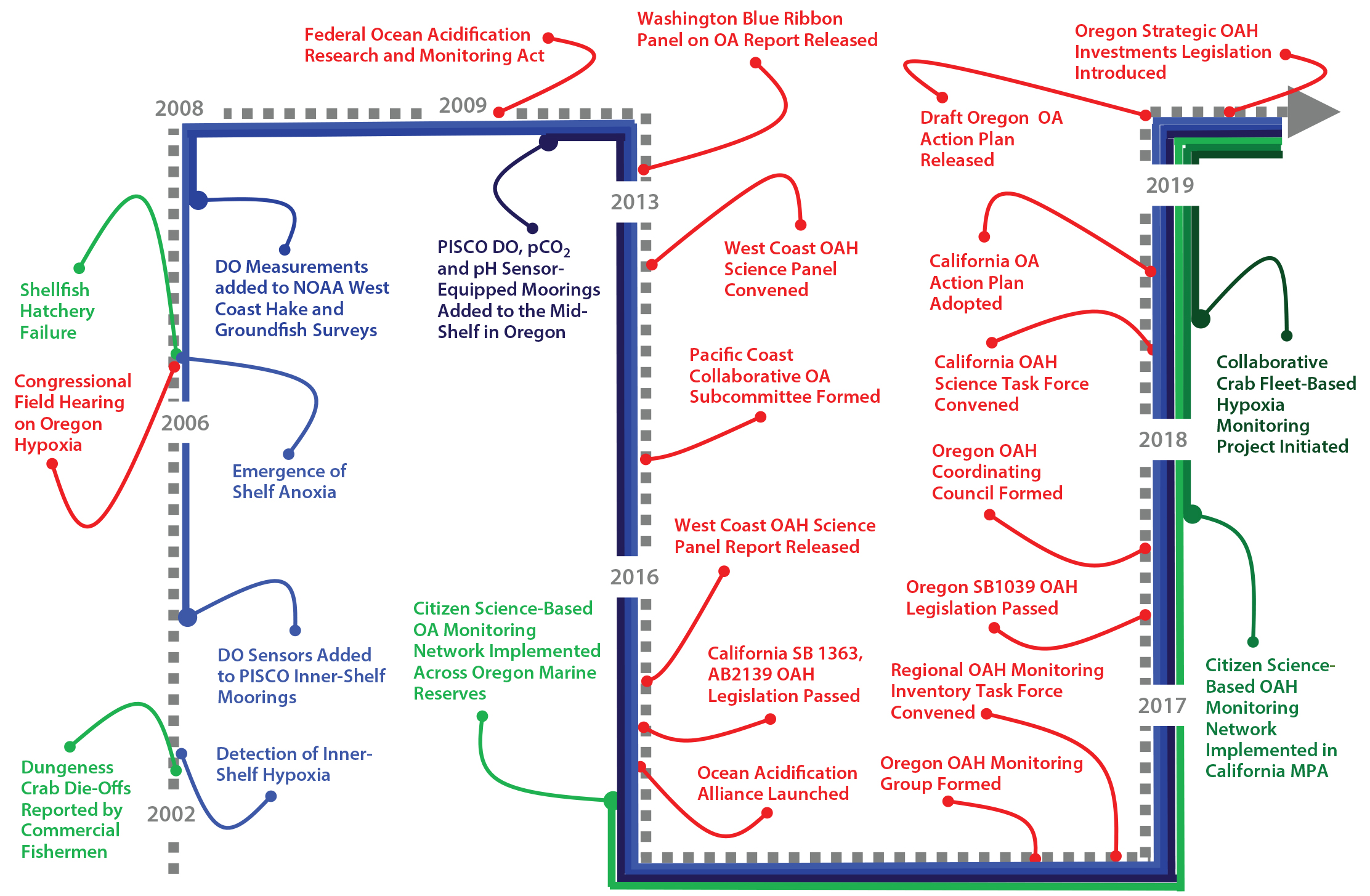
Figure 5. Timeline highlighting advances in ocean acidification and hypoxia (OAH) stakeholder engagement (green), the foundational science (blue), and resulting policy actions (red). The timeline highlights major milestones in which PISCO was directly involved. Blue and green lanes represent the growth of PISCO and PISCO partnerships for in situ observation programs to detect and track OAH in California Current Large Marine Ecosystem nearshore waters. Note the acceleration of policy actions over the past three years. > High res figure
|
Finally, PISCO has engaged coastal citizens and fishers to help them understand the changes in “their” ocean and participate in monitoring changes through citizen science efforts (see Box 3 in Chan et al., 2019, in this issue). A new project is developing DO monitoring capability for the commercial Dungeness crab fishing fleet. These efforts expand the availability of OAH data and empower new partners in OAH education and development of solutions.
3. Sea Star Wasting, Marine Diseases, and Public Awareness
The earliest reports of what would become the most massive mortality of sea stars ever recorded along the west coast of North America came in June 2013 from the outer coast of Washington. By spring 2014, the outbreak of this sea star wasting syndrome (SSW) had spread along most of the West Coast and devastated all 20+ coastal sea star species (Stokstad 2014; Menge et al., 2019b, in this issue). This alarming event attracted intense attention by marine biologists, wildlife disease specialists, and media.
The existence of long-term, spatially extensive data sets on intertidal and subtidal community structure (abundance and diversity of fishes, invertebrates, and macrophytes) and an understanding of community dynamics provided the context for documenting, understanding, and responding to the event (e.g., Menge et al., 2016; Miner et al., 2018; Moritsch and Raimondi, 2018). PISCO and MARINe (Multi-agency Rocky Intertidal Network; https://marine.ucsc.edu/data-products/sea-star-wasting/) research teams quickly initiated high-frequency surveys to document the event and forge new collaborations among microbiologists, disease biologists, and aquarists to understand the proximate and ultimate causes of the outbreak. When SSW peaked in summer 2014, it had already devastated many species and locally extirpated others. As of 2019 (Harvell et al., 2019), some species such as the sunflower sea star Pychnopodia helianthoides have not recovered, but other common stars, such as the iconic intertidal keystone predator Pisaster ochraceus, appear to be slowly recovering through recruitment of new individuals, despite suffering exceptionally high mortality. Chronic, low level SSW persists.
Public engagement was spurred by exponentially growing media reports in spring 2014 as the unprecedented nature of the event became known. Numerous interviews of PISCO PIs and MARINe scientists appeared in local-to-international media outlets (e.g., The New York Times, Washington Post). This interest has persisted, with requests for information from the media and citizens through 2019. One entrepreneurial PISCO graduate student, Jenna Sullivan-Stack, engaged the nationally famous Rogue Brewery in Newport, Oregon, to create a special brew, called Wasted Sea Star Purple Pale Ale, to increase public awareness of the phenomenon and generate additional financial resources for research (Figure 6).
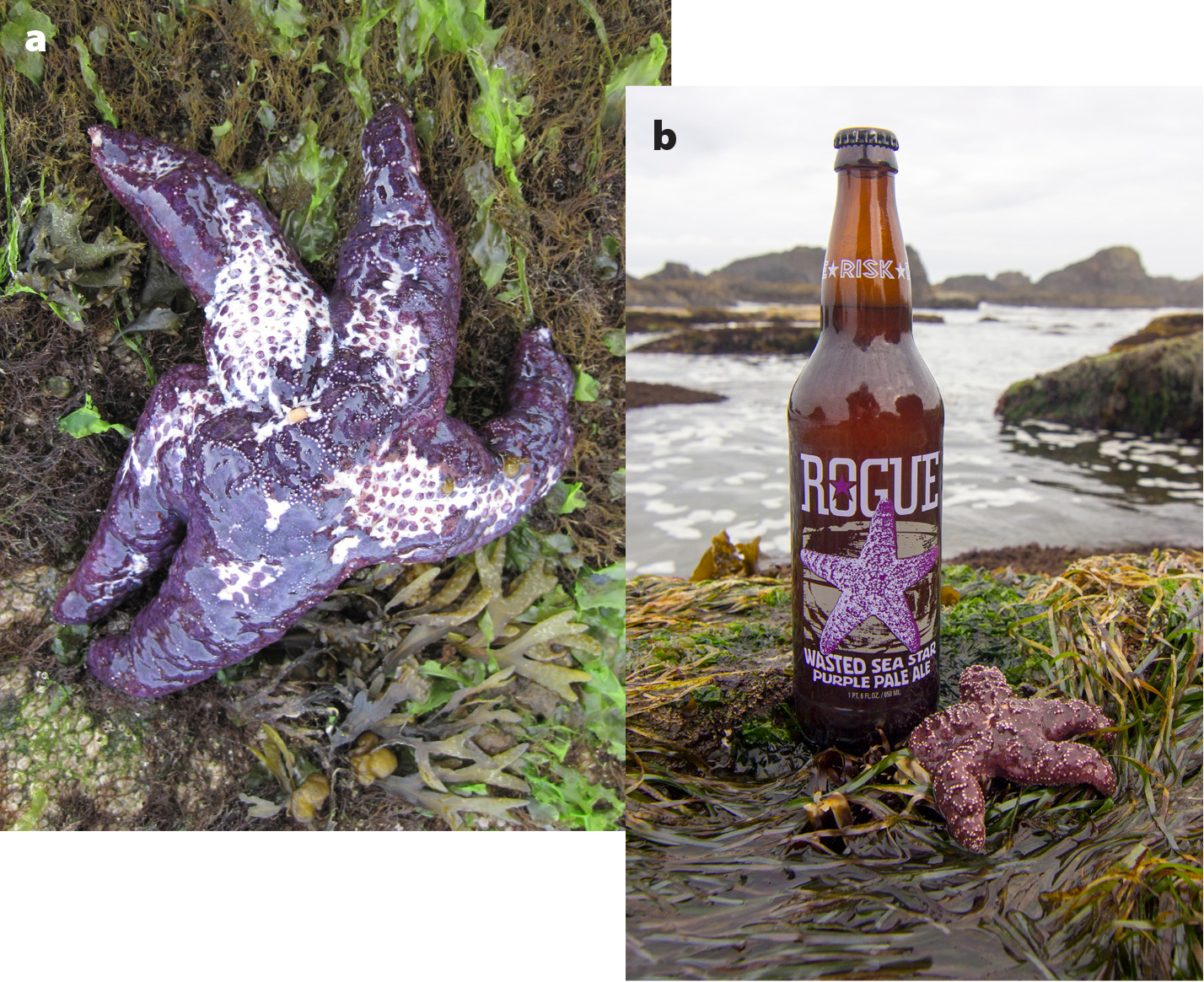
Figure 6. (a) Pisaster ochraceus with lesions indicting early signs of sea star wasting. Photo credit: Melissa Miner (b) Rogue Ales & Spirits produced the Wasted Sea Star Purple Pale Ale, with proceeds going to fund research on sea star wasting. Photo credit: Rogue Ales & Spirits, 2019. > High res figure
|
Media attention triggered interest from the Association of Fish and Wildlife Agencies (AFWA), which was developing legislation for federal funding of wildlife disease outbreaks. PISCO PIs participated in a 2014 AFWA-organized workshop and collaborated on a white paper on wildlife diseases for national policymakers and private funders. PISCO postdoctoral scholar Sarah Gravem and PI and author Menge led the creation of a Sea Star Wasting Syndrome Task Force of researchers, conservation biologists, fisheries and wildlife scientists, aquarium and veterinary specialists, and citizen scientists to develop a strategic action plan. Goals included engaging partners in four tasks: diagnostics and epidemiology; surveillance and ecology; management, conservation, and recovery; and communication, outreach, and citizen science. As of July 2019, this effort is ongoing.
Reflections and Conclusions
PISCO’s culture of outreach facilitated engagement with stakeholders, managers, and policymakers, and this interaction has strengthened through time, with PISCO scientists now routinely providing trusted input, and demonstrating that academic scientists can be helpful, useful, and understood. Although the program’s organization has changed across the 20 years (Menge et al., 2019c, in this issue), the consortium has prioritized the effort to anticipate and be responsive to management and policy needs.
Interestingly, and counter to some national trends, these productive interactions between scientists and society regarding ocean issues do not seem to be undermined by the emergence of the “post-truth” world of today. Perhaps some of the post-truth antidotes espoused by Lubchenco (2017), Lubchenco and Gaines (2019), and Oreskes (in press) have been in play along the West Coast: personal relationships between scientists and users of scientific information; an openness to information exchange; scientists trained to be effective at communication and engagement; a focus on finding solutions, not just identifying problems; giving citizens the opportunity to co-create knowledge through citizen science; a culture of valuing open inquiry, evidence, data sharing, and transparency; and an overarching focus on science to serve society.
Time and again—across the examples from MPAs, OAH, and SSW—successes in connecting science to policy and management at the local and state level have resulted in that same science or policy solution being embraced at national and international levels. Moreover, in all of these instances, the interactions of science with decision-makers has been multidirectional, with policymakers or citizens influencing directions of science as well as scientific findings triggering new awareness, policy, and action.
Acknowledgments
We thank our primary funders, especially the initial and continuing funder, the David and Lucile Packard Foundation, and later the Gordon and Betty Moore Foundation, for supporting a focus on linking science, policy, and public understanding. We appreciate the willingness of our collaborators in state and federal agencies to work together toward collective understanding and solutions. We gratefully acknowledge the key role played by the PISCO Policy Coordinators, Satie Airamé, Lydia Bergen, Renee Davis, Liz Riley, Emily Saarman, and Cinamon Vann, in many of the successes described herein. This is PISCO publication #502.

